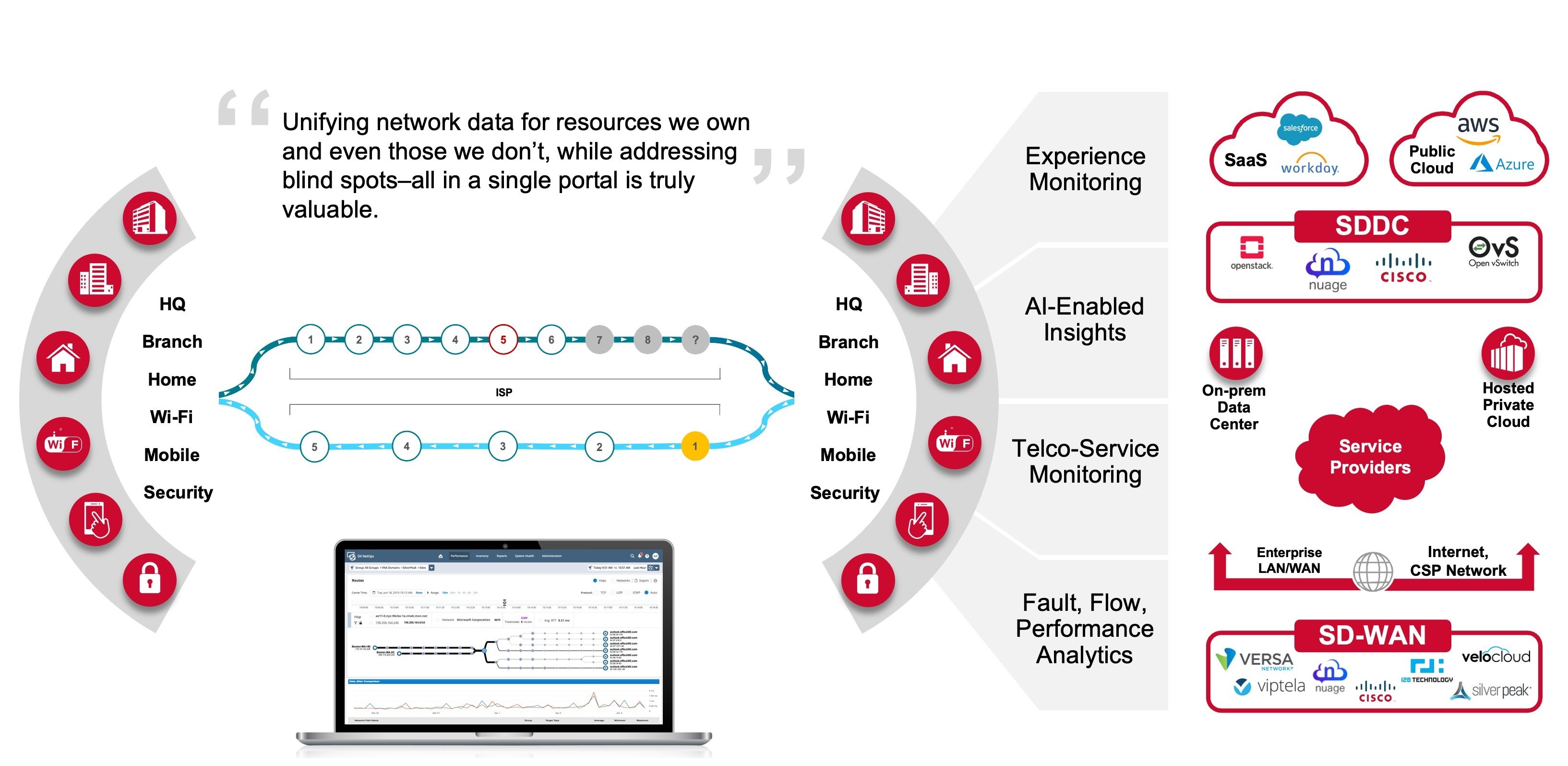June 23, 2025

Harnessing Network Observability to Speed the Telco-to-Techco Transition

Written by: Arnold Hoogerwerf
|
Key Takeaways
|
|
For telecommunications firms (telcos), the race is on. If these organizations are to rise to meet their top challenges and growth objectives, transformation is a must. Those who make this move most rapidly will be best positioned for sustained success.
Today, telcos face several significant challenges, which are creating fundamental disruption:
- Core connectivity services are becoming commoditized. Voice, data, cable television, and other traditional services have grown highly commoditized, with pricing under constant pressure.
- Competition is increasing. Today’s telcos aren’t just competing with other incumbents. Large cloud service providers like Amazon, Google, and Microsoft now pose significant competitive threats. These providers now deliver a range of services to enterprises, including cloud connectivity, edge computing, and network functions as a service. Given this, they’re starting to cut telcos out of the value chain.
- Market demands are shifting. Leaders in enterprises and government agencies are pursuing critical digital transformation initiatives. As these organizations change, so do their service requirements. Now, leaders are looking for end-to-end solutions that are aligned with their specific industries, compliance requirements, and top-level objectives.
Telcos need to transform to contend with these shifts. They must move beyond their traditional role of communication service providers and instead become technology-enabled service providers. Quite simply, they must move from being telcos to technology companies (techcos).
Characteristics of the telco-to-techco transformation
The telco-to-techco transformation is a broad-based, multi-faceted effort that includes these elements:
- Digital transformation. Telcos need to embrace digital transformation, just like the enterprises they serve. For telcos, this means making a shift from managing infrastructure to providing digital solutions. This move requires telcos to modernize legacy systems, employ cloud-native architectures and agile methodologies, and cultivate a culture of innovation.
- Diversification into tech services. Telcos are seeking to expand their offerings, moving beyond their core connectivity services. Now telcos are entering such areas as enterprise IT services, cloud computing, IoT, AI, and cyber security. This requires a range of new advanced technology investments and digital platform integrations.
- Move to cloud and edge computing. The rise of 5G networks, edge computing, and other technology innovations represent key business enablers for telcos. For instance, 5G can enable the delivery of new services and models, including network slicing, private networks, and industry-specific, low-latency apps.
- Partnerships and ecosystem plays. Many telcos will profit through collaboration with cloud providers, software companies, and other tech players. This enables firms to leverage complementary expertise and solutions to fuel service enhancements.
- Customer experience and personalization. To compete in their increasingly crowded markets, telcos need to find ways to deliver increasingly personalized and optimized customer experiences. This will require enhanced data analytics, which can help teams identify, provide, and optimize customer-focused service offerings.
Limitations of traditional monitoring
As telcos make the transition to becoming techcos, traditional network monitoring tools and approaches will represent an increasingly significant obstacle. That’s because these tools fall short in several areas:
- Cloud-native infrastructure. As telcos progress in their digital transformation, they’ll grow increasingly reliant upon cloud-native infrastructures. To manage these environments effectively, operations teams require deep visibility into containers, virtual machines, and APIs. The problem is that legacy monitoring tools weren’t built for tracking these technologies. This limitation can pose a significant hindrance to modernization efforts.
- AI and automation. To meet their operational and business imperatives, telcos will need to embed AI and automation into their operations. However, traditional, siloed tools offer limited, fragmented visibility that impedes the establishment of predictive, AI-driven operations.
- Partner ecosystems. Currently, many telcos are seeking to expand their partnerships, such as with cloud providers, systems integrators, and industry solution providers. These expanding partnerships will make it much more critical for operations teams to extend their visibility across organizational and technical boundaries, including third-party domains. If teams lack the visibility required, telcos can have their collaborative initiatives stifled and they risk missing SLAs for services that do get delivered.
- New service offerings. To compete, telcos will increasingly be offering premium services, such as observability as a service. To make their offerings stand out, they’ll seek to provide differentiated SLAs, such as basing guarantees on actual user experience, rather than rudimentary availability or performance metrics. Traditional tools lack the insights needed to support these approaches.
- Industry-specific offerings. Within many telcos, leaders are looking to grow their market reach by offering industry-specific solutions. These solutions inevitably introduce added layers of complexity, such as industry-specific KPIs and distinct multi-tenancy requirements. Traditional tools lack the scale and operational efficiency required, inhibiting the delivery of these differentiated offerings.
- Personalization. Fundamentally, personalization is all about the user experience. The problem is that teams in many telcos can’t effectively measure what the user experience is actually like. This limited visibility diminishes monetization opportunities, and it makes it harder to deliver the rewarding experiences that promote loyalty.
- Omni-channel support. Today’s organizations are operating in an omni-channel world, where customers may interact with businesses in multiple ways. With legacy tools, teams struggle to correlate app performance with network conditions and user behavior. This makes it time consuming to pinpoint issues and difficult to ensure an optimized experience across channels.
To put it more succinctly, with legacy monitoring tools, modernization efforts are stifled, service level commitments are missed, and user experience is suboptimal.
Observability and analytics: New imperatives
To overcome all the hurdles presented by legacy tools, telcos need a modern observability platform. Here are a few of the key requirements the platform must meet:
- Full-chain visibility. Network operations teams need end-to-end visibility, including across physical networks, public and private cloud, virtual infrastructure, and edge computing. This enables teams to gain the insights needed to track and optimize service levels in modern environments.
- Real-time analytics, AI integration. Teams need real-time, AI-powered analytics. These analytics are now essential for establishing predictive operations, closed-loop automation, and ecosystem-wide visibility.
- Experience metrics. Teams now need more than just monitoring data. For true observability, they must have effective experience metrics, such as application response time or voice conferencing quality. With these capabilities, telcos can monetize services based on customer outcomes, not just up time.
- Multi-tenancy and industry support. Observability platforms must support multi-tenancy and industry-specific customization. This enables telcos to track industry-specific KPIs, expand support for business-to-business services, and provide users with self-service access.
- Flexible and deep integrations. Teams need observability platforms that provide deep integrations with other technologies, including customer data platforms and DevOps pipelines. With these integrations, data from disparate systems starts to flow together, enabling telcos to achieve better personalization, faster rollouts, and more proactive services.
Solution: Network Observability by Broadcom
For today’s telcos, observability is about much more than monitoring. Observability represents a business enabler, one that can help teams boost differentiation and revenues. Now, observability is a key requirement for making the telco-to-techco transition successfully.
Network Observability by Broadcom delivers the essential capabilities that today’s telcos need. With the solution, your teams can bring together data from different tools and layer intelligence on top of it—so they can gain true observability.
The solution enables you to establish unified, end-to-end visibility across your hybrid environments, including clouds (whether public, private, or virtual private), internal and third-party managed networks, SD-WAN environments, and more.

Network Observability by Broadcom helps fuel the telco-to-techco transformation.
Network Observability by Broadcom delivers the following key advantages:
- End-to-end, cross-domain visibility. Network Observability by Broadcom delivers visibility across the entire ecosystem—no more visibility gaps. The solution provides end-to-end coverage of connectivity paths, including those that span internally managed and externally managed, third-party networks. It also delivers centralized coverage, even for resources operated by third parties.
- Service-level, user-experience metrics. The solution enables you to track the true user experience, capturing metrics like DNS lookup delays, path latency, app response times, voice call quality, and more. With the solution, you can do real-time SLA tracking, which enables the delivery of tiered service offerings that are tied to measurable KPIs. As a result, you can move from offering bandwidth to delivering performance outcomes.
- Insight-driven monetization. With the solution, you can aggregate data like latency maps, app usage patterns, and infrastructure health. This data can be a powerful asset. Telcos can leverage this data to build consumption-based revenue models, charging partners, ISVs, and developers to tap into their observability fabric.
- Operational efficiency. Network Observability by Broadcom helps teams reduce complexity, boosting performance and team efficiency. Harnessing AI and machine learning, the solution delivers actionable insights that fuel fast remediation and proactive management.
Conclusion
To meet their growth objectives, telcos need to transform to become techcos. To make this transition happen successfully, network observability is a must. Network Observability by Broadcom offers unified and comprehensive visibility, enabling you to enhance performance, mitigate risk, and promote better business outcomes. With all of its advanced capabilities, the solution represents a strategic business enabler that helps telcos become successful techcos.
To learn more, see our Small Bytes webcast, From TELCO to TECHCO and the crucial role of Network Observability.
Other resources you might be interested in
3 Questions I Expect You to Ask Me
Ask these questions to gain a deeper understanding of a vendor. Find a partner who can solve today’s challenges and prepare you for what’s next.
Carrier-Grade Network Observability: A Technology Brief for Telco Network Operations
Network Observability by Broadcom unifies data to provide contextual, AI-enabled insights for superior service availability, accelerated MTTR and improved MTTI, reduced operational costs, and the...
You've Found the Waste In Your Network Operations. Now What?
Leverage the Six Sigma framework to gain a roadmap for converting network data into permanent optimizations. Start systematically eliminating network issues.
AAI Integrations: Control-M
This course explains how to install, configure, and secure the integration between Automation Analytics & Intelligence (AAI) and Control-M.
The Silent Sabotage of Configuration Drift
See how manual network changes lead to configuration drift, which can cause security holes, compliance violations, and network outages.
AAI - Configuring & Responding to Jobstream Alerts
This course walks you through how jobstream alerts work in AAI, and how to tailor them to your workload needs.
Rally Office Hours: November 20, 2025
Get the scoop on the latest Rally updates, including new AI features, customizable planning boards, and essential tips for managing service accounts and custom views.
AAI Fundamentals
Gain a solid introduction to Automation Analytics and Intelligence (AAI)—a powerful platform that unifies and optimizes automated workflows across complex IT environments.
Is Your Network Modernization Frozen by Fear?
See how the “if it ain’t broke, don’t fix it” mindset delays many network modernization projects. Employ network observability and migrate with confidence.